List of recorded datu in the Philippines
The datu have ruled over portions of the islands that are now the Philippines before Spanish colonization in the 16th century. This article lists the pre-colonial leaders of individual kingdoms and polities in Philippine history.
Tondo Dynasty
| Name | Image | Title held | From | Until |
|---|---|---|---|---|
| Unknown, represented by Hwan Nāyaka Jayadewa of Pailah in the LCI | 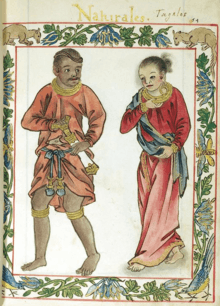 | Senapati (analogous to "admiral") | 900? | ? |
| Timamanukum | Lakan Timamanukum | 1150? | ? | |
| Alon | 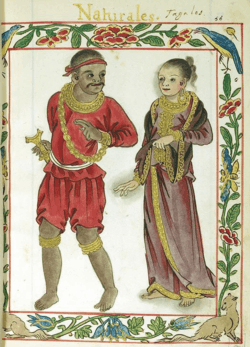 | Lakan Alon | 1200? | ? |
| Gambang | Lakan Gambang | 1390? | 1417? | |
| Suko | Lakan Suko | 1417? | 1430? | |
| Lontok | Rajah Lontok | 1430? | 1450? | |
| Kalangitan | Dayang Kaylangitan, Queen of Namayan and Tondo | 1450? | 1515? | |
| Salalila | Rajah Salalila or Rajah Sulayman I | 1515? | 1558? | |
| Matanda | 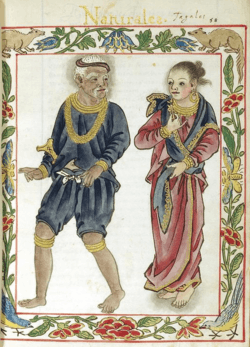 | Rajah Matanda or Rajah Sulayman II or Rajah Ache, King of Namayan | 1558? | 1571 |
| Lakan Dula | Banaw Lakandula, King of Tondo and Sabag | 1558? | 1571 | |
| Sulayman | Rajah Sulayman III, King of Tondo | 1571 | 1585 | |
| Magat Salamat | 1575 | 1587 | ||
| Pre-Colonial History of the Philippines |
 |
|---|
| Barangay government |
| Ruling class (Maginoo): Datu (Lakan, Raja, Sultan) |
| Middle class: Timawa, Maharlika |
| Serfs, commoners and slaves (Alipin): Horohan, Alipin Namamahay, Alipin sa gigilid, Bulisik, Bulislis |
| The book of Maragtas |
| States in Luzon |
| Caboloan (Pangasinan) |
| Ma-i |
| Rajahnate of Maynila |
| Namayan |
| Tondo |
| States in the Visayas |
| Kedatuan of Madja-as |
| Kedatuan of Dapitan |
| Kingdom of Mactan |
| Rajahnate of Cebu |
| States in Mindanao |
| Rajahnate of Butuan |
| Sultanate of Sulu |
| Sultanate of Maguindanao |
| Sultanates of Lanao |
| Key figures |
|
| History of the Philippines |
| Portal: Philippines |
The Datus of Madja-as
| Commander-In-Chief | Image | Jurisdiction | From | Until |
|---|---|---|---|---|
| Datu Thel | Kabuyaw | 13th century | 1212 | |
| Datu Anne | Kabuyaw | 13th century | 1212 | |
| Datu Puti | Whole Aninipay | 13th century | 1212 | |
| Datu Sumakwel | Antique | 12 century-Borneo | ||
| Datu Lubay | Malandug | ? | ? | |
| Datu Paiburong | Irong-Irong | ? | ? | |
| Datu Paduhinog | Malandug | ? | ? | |
| Datu Bankaya | Kalibo | 1365 | 1437 | |
| Datu Dumangsol | Malandug | 1437- | ? | |
| Datu Dumalugdog | IMalandug | ? | ? | |
| Datu Dumangsil | Taal | ? | 1565 | |
| Datu Balensucla | Taal | ? | ? |
Rulers of the Maynila
| Name | From | Until |
|---|---|---|
| Sultan Bolkiah | 1500 | ? |
Monarchs of the Butuan Kingdom
| The Royal Title of the Reigning Rajah | Image | Events | From | Until |
|---|---|---|---|---|
| Rajah Kiling | The Embassy of I-shu-han (李竾罕) | 989 | 1009 | |
| Sri Bata Shaja | Mission by Likanhsieh (李于燮) | 1011 | ? | |
| Rajah Siagu | Annexation by Ferdinand Magellan | ? | 1521 | |
Rajas of Cebu
| The Royal Title of the Reigning Rajah | Image | Events | From | Until |
|---|---|---|---|---|
| Sri Lumay | ? | |||
| Rajah Humabon | Annexation by Ferdinand Magellan | ? | ||
| Rajah Tupas | Spanish Period | |||
Sultans of Maguindanao
| Reign | Sultan | Other name(s) | |
|---|---|---|---|
| 1520–1543 | Shariff Kabungsuwan | A Johore (Singapore) Makdum Prince who fled to Malabang Lanao and seated as Sharif Kabungsuwan. Married the daughter of Chieftain Aliwya of the Maguindanao family clan at Dulawan, Cotabato. Took over the father inlaw's political powers establishing the Sultanate of Maguindanao later called by the Spanish as Mindanao. He is the second Makdum known as Karim Ul-Makdum who reinforced Islam and His brother Sulu Sultan Shariful Hashim promulgated Kor'anic studies or Madrassahs.
The said Sharif is buried at Simunul Island Tamppat. | |
| 1543–1574 | Sultan Maka-alang Saripada | ||
| 1574–1578 | Sultan Bangkaya | ||
| 1578–1585 | Sultan Dimasangcay Adel | ||
| 1585–1597 | Sultan Gugu Sarikula | Datu Salikala | |
| 1597–1619 | Sultan Laut Buisan | Datu Katchil | |
| 1619–1671? | Sultan Muhammad Dipatuan Kudarat | Datu Qudratullah Katchil | |
| 1671?–1678? | Sultan Dundang Tidulay | Sultan Saif ud-Din (Saifud Din) | |
| 1678?–1699 | Sultan Barahaman | Sultan Muhammad Shah Minulu-sa-Rahmatullah | |
| 1699–1702 | Sultan Kahar ud-Din Kuda | Maulana Amir ul-Umara Jamal ul-Azam | |
| 1702–1736 | Sultan Bayan ul-Anwar { Maruhom Batua } | Dipatuan Jalal ud-Din Mupat Batua (posthumously) | |
| 1710–1736 (in Tamontaka) | Sultan Amir ud-Din | Paduka Sri Sultan Muhammad Jafar Sadiq Manamir Shahid Mupat (posthumously) | |
| 1736–1748 (in Sibugay, Buayan, Malabang) | Sultan Muhammad Tahir ud-Din | Dipatuan Malinug Muhammad Shah Amir ud-Din | |
| 1733–1755 (paramount chief of Maguindanao by 1748) | Sultan Rajah Muda Muhammad Khair ud-Din | Pakir Maulana Kamsa Amir ud-Din Itamza Azim ud-Din Amir ul-M'umimin | |
| 1755–1780? | Sultan Pahar ud-Din | Datu Panglu/Pongloc Mupat Hidayat (posthumously) | |
| 1780?–1805? | Sultan Kibad Sahriyal | Muhammad Azim ud-Din Amir ul-Umara | |
| 1805?–1830? | Sultan Kawasa Anwar ud-Din | Muhammad Amir ul-Umara Iskandar Jukarnain | |
| 1830–1854 | Sultan Qudratullah Untung | Iskandar Qudratullah Muhammad Jamal ul-Azam Iskandar Qudarat Pahar ud-Din. Properly place, his name was Ullah Untong and seated as Sultan Ashrf Samalan Farid Quadratullah or better known as Sultan Qudarat. www.royalsultanate.weebly.com | |
| 1854–1884 | Sultan Muhammad Makakwa | ||
| 1884–1888 | Sultan Wata | Sultan Muhammad Jalal ud-Din Pablu | |
| 1888–1896 | No sultan Sultan Anwar ud-Din contested Datu Mamaku (son of Sultan Qudratullah Untung) of Buayan for the throne versus the then sultan Datu Mangigin of Sibugay. | ||
| 1896–1898 | Sultan Taha Colo | Sultan Rabago sa Tiguma | |
| 1908–1933 | Sultan Mastura Kudarat | Sultan Muhammad Hijaban Iskandar Mastura Kudarat, Sultan Mastura | |
The Sultans of Sulu (1405–present)
| Sultans | Image | From | Until |
|---|---|---|---|
| Sharif ul-Hashim of Sulu |  | 1480 | 1505 |
| Sultan Kamalud-Din |  | 1505 | 1527 |
| Sultan Amirul-Umara | 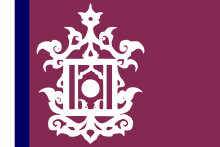 | 1893 | 1899 |
| Jamal ul-Kiram I |  | 1893 | 1899 |
| Mahakuttah Kiram | 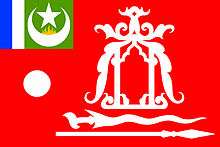 | 1974 | 1986 |
| Muedzul Lail Tan Kiram |  | 1986 | |
Datus in the Maragtas epic
- Datu Kalantiaw III /Rajah Bendahara Kalantiaw, according to the local oral tradition of Panay, is said to have enacted a body of laws, which is now called the Code of Kalantiaw in 1433.
- Datu Puti – One of the 10 Bornean Datus to arrive in Iloilo before the Spanish colonization.
- Datu Sumakwel – Leader of the 10 Bornean Datus. He settled in Antique.
- Datu Bangkaya
- Datu Paiburong
- Datu Marikudo – the Ati (Aeta) Datu of Panay, from whom the 10 Bornean Datus purchased the lowlands of the Island, in exchange for a golden Salakot (Bulawan nga Saduk), and a long pearl necklace that could touch the ground (Manangyad).
Datus during the Spanish colonization
- Rajah Colambu – King of Limasawa in 1521, brother of Rajah Siagu of Butuan. He befriended Portuguese explorer Ferdinand Magellan and guided him to Cebu on April 7, 1521.
- Rajah Humabon – King of Cebu who became an ally of Ferdinand Magellan and the Spaniards. Rival of Datu Lapu-Lapu. In 1521, he and his wife were baptized as Christians and given Christian names Carlos and Juana after the Spanish royalty, King Carlos and Queen Juana.
- Sultan Kudarat – Sultan of Maguindanao.
- Lakan Dula or Lakandula – King of Tondo, one of the last princes of Manila.
- Datu Lapu-Lapu – King of Mactan Island. He defeated the Spaniards on April 27, 1521.
- Datu Sikatuna – King of Bohol in 1565. He made a blood compact with Spanish explorer, Miguel López de Legazpi.
- Datu Pagbuaya – King of Bohol. He governed with his brother Datu Dailisan, a settlement along the shorelines between Mansasa, Tagbilaran and Dauis, which was abandoned years before the Spanish colonization due to Portuguese and Ternatean attacks. He founded Dapitan in the northern shore of Mindanao.
- Datu Dailisan – King of Mansasa, Tagbilaran and Dauis and governed their kingdom along with his brother Datu Pagbuaya. His death during one of the Portuguese raids caused the abandonment of the settlement.
- Datu Manooc – baptized as Pedro Manuel Manooc, son of Datu Pagbuaya who converted to Christianity, defeated the Higaonon tribe in Iligan, Mindanao. He established one of the first Christian settlements in the country.
- Datu Macabulos – King of Pampanga in 1571.
- Rajah Siagu – King of the Manobo in 1521.
- Apo Noan – Chieftain of Mandani (present day Mandaue) in 1521.
- Apo Macarere – Famous Chieftain of the Tagbanwa warrior tribe in Corong Island (Calis).
- Rajah Sulaiman III – One of the last King of Manila, was defeated by Martín de Goiti, a Spanish soldier commissioned by López de Legazpi to Manila.
- Rajah Tupas – King of Cebu, conquered by Miguel López de Legazpi.
- Datu Urduja – Female Leader in Pangasinan.
- Datu Zula – Chieftain of Mactan, Cebu. Rival of Lapu-lapu
- Datu Kalun – born Pedro Cuevas Javiér on May 6, 1845 from Bacoor, Cavite. Ruler of the Island of the Basilan and the Yakans in Mindanao, defeated the real Datu Kalun after a Yakan-Chavacano confrontation, assumed the title and converted his line to Catholicism. Founder of Lamitan City.
- Datu Sanday – Ruler of Marawi City
- Datu Saiden Borero – King of Antique
- unnamed Datu – King of Taytay Palawan. Mentioned by Pigafetta, chronicler of Magellan. The king, together with his wife were kidnapped by the remnant troops from Magellan's fleet after fleeing Cebu to secure provisions for their crossing to the Moluccas.
- Datu Cabaylo (Cabailo) – The last king of the Kingdom of Taytay
- Datu Piang - the most prominent datu of Cotabato during the late Spanish period up to the American era. He is also the first Governor of Cotabato.
Present day Datus in Mindanao
1. Muslim Datus in Mindanao
In some indigenous Lumad and Muslim societies in Mindanao, titular Datus of ancient royal and noble families still exist. Some of them are active government officials of the Republic of the Philippines, while continuing their cultural and tribal roles as community leaders of their people. Some, although do not have official duties in the Republic, exercise some leadership roles in their tribes. Still others are claimants to these titles. Some of these present day Datus are:
- Datu Andal Ampatuan Sr. – Present datu and one of the most infamous among datus, because he is the culprit of Maguindanao Massacre.
- Datu Pax S. Mangudadato – Present day datu and governor of Sultan Kudarat (2001–2004)
- Datu Zaldy Ampatuan – Regional Governor, Autonomous Region in Muslim Mindanao
- Datu Zamzamin Ampatuan – Undersecretary, "Department of Energy"
- Datu Micko Alunan S. Ampatuan also known as Datu Alunan – born in 1995, was the next in line to the datus. He is the successor of Datu Andal Ampatuan Sr..
- The Sultanate of Sulu has had succession of titular Sultans[1] during the past decades: Mohammad Jamalulul Kiram III (1984–1990);[2][3] Mohammad Akijal Atti (1990–1999), who was Raja Muda to self-proclaimed Sultan Mohammad Jamalulul Kiram III before he assumed the title as self-proclaimed titular Sultan;[4][5][6] However at present, the legitimate ruling house of the Sultanate of Sulu (Cf. Royal Sultanate of Sulu), states Raja Muda Muedzul Lail Tan Kiram of Sulu is the legitimate head and Sultan of Sulu. Datu Muedzul Lail Tan Kiram was crowned in 1974 as Raja Muda ( Crown Prince) through an official Memorandum Order N. 427, issued by Philippine President Ferdinand E. Marcos.[7][8] He was crowned beside his father, Sultan Moh. Mahakuttah A. Kiram, the last Philippine Government recognised Sultan of Sulu.[9] Muedzul Lail Tan Kiram is the last Raja Muda (Crown Prince) of Sulu to receive official recognition from a Philippine President.[10][11]
- The Sultanate of Maguindanao has an incumbent titular Sultan, Hajji Datu Amir bin Muhammad Baraguir – the 25th Sultan of Maguindanao.Son of Al-Marhum Sultan Hajji Datu Muhammad G.M. Baraguir,Llb. the 24th Sultan of Maguindanao[12]
- The Maranaos have sixteen royal houses who rule the four principalities in what is referred to as the Confederation of Sultanates in Lanao.
2. Lumad Datus in Mindanao
- Datu Julius Cayon
- Datu Viloso Suhat, also known as Datu Lipatuan – a tribal leader from the Tinananon Menuvo tribe in Arakan, North Cotabato, and the first Lumad to sit in a local legislative body in central Mindanao.[14]
- Datu Lamparan Talima Danda – the tribal chief from Subanen tribe, and a second generation descendant of Timuay Danda Antanao from Kabasalan, Zamboanga Sibugay. Elected Mayor of Kabasalan, serving from 1961 to 1964. He was the Secretary General of United Subanen Community Association Inc.
- Datu Wata Eduardo Lihao Danda- a tribal leader in charge of the communications for the entire Subanen Tribe. He functioned under Datu Lamparan Lihao Danda, his elder brother. He was enlisted into United States Armed Forces of the Far East (USAFFE) during World War II, attach to the Medical Detachment of 106th Infantry (Filipino) Division with rank of Corporal, and captured by the Japanese in May 1942. Datu Wata Eduardo was imprisoned in Camp 78 in Davao, escaped the same year and re-joined with US Army 41st Division. After the liberation of the Philippines from Imperial Japanese forces, he reenlisted to the Philippine Constabulary and retired in 1972. He served as the Secretary General of United Subanen Community Association, Inc. in Zamboanga Sibugay, succeeding his elder brother.
- Datu Labi José Lihao Cayon – a tribal chief of the Subanen tribe and the 1st cousin of Datu Wata Eduardo Lihao Danda and Datu Lamparan Lihao Danda
- Datu Labi Julius Mascarinas Cayon – board member of Zamboanga Sibugay Province And the Son of late Datu Labi JoseLihao Cayon, he is recognized as the Tribal Chieftain not just in Zamboanga Sibugay but entire Region 9 and partly in Region 10. "NCIP" - national commission on indigenous people, record section.
- Datu Lumok Imbing – 2nd cousin of Datu Laparam Talima Danda and a tribal leader from Subanen Tribe, who leads the aborigins of the Municipality of Lapuyan, Zamboanga Del Sur Province.
- Datu Wilborne Sanghanan Danda – a board member of Sangguniang Panlalawigan of Zamboanga Sibugay (2000–2013), Elected Vice Mayor of Municipality of Kabasalan, Zamboanga Sibugay from year 2010–2013, He is the son of Datu Lamparan Talima Danda.
- Datu Langhap Dacanay – he is the 2nd generation of the royal blood stream and a 3rd degree relative of Datu Wilborn Sanghanan Danda
- Bae Sonita Manda Ryde – the 1st highest women handle the position she was proclaimed by former President Gloria Arroyo and she is in the 2nd generation royal blood stream a relative of Datu Lamparan T. Danda, Datu Wata Eduardo Lihao Danda and Datu Labi Jose Lihao Cayon
- Datu Wilfredo Lunsayan Sunggayan – 1st Indigenous Peoples representative in local legislative councils in the Province of Zamboanga Sibugay an none blood stream ordained appointed as Datu for Subanen political affair from the provincial down to the barangay level pursuant to RA 8371.
See also
- President of the Philippines
- Governor General of the Philippines
- Heads of state and government of the Philippines
- List of sovereign state leaders in the Philippines
- List of ancient Philippine consorts
- Indian honorifics, Filipino, Indonesian, Malay and Thai titles originated from these
- Thai honorifics
- Thai royal and noble titles
- Malay styles and titles
- Filipino styles and honorifics
- Indonesian honorifics
- Greater India
- Indosphere
References
- Sultan of Sulu
- ‘Sultan of Sulu’ attends wedding in Malaysia | Free Malaysia Today Archived 2011-09-08 at the Wayback Machine
- Jamalul Kiram III was a member of the Rumah Bichara (Council of the Sultan) during the reign of his late uncle, Sultan Esmail Kiram (1962–1974). He himself acted as "Interim Sultan" during the absence of his father Punjungan Kiram while in Sabah (1974–1981) and proclaimed himself in 1984 as Sultan of Sulu. He was crowned on June 15, 1986 in Jolo, Sulu.
- Titular Sultan of Sulu from 1990–1999
- Ismael Kiram II is the second son of Punjungan Kiram and younger brother of Jamalul Kiram III, and titular Sultan of Sulu since 1999.
- Welcome to the Royal Hashemite Sultanate of Sulu & Sabah Official Website
- Sultan of Sulu
- "Asia America Initiative". Asia America Initiative. Archived from the original on 28 September 2011. Retrieved 25 April 2011.
- "Memo Order 427". Royal House of Sulu. Archived from the original on 26 June 2011. Retrieved 25 April 2011.
- Sulu sultan’s ‘heirs’ drop Sabah claim – INQUIRER.net, Philippine News for Filipinos Archived 2013-07-03 at the Wayback Machine
- So, who’s the real sultan? Archived 2012-10-06 at the Wayback Machine
- The Sultans: Members Family Of The Royal House Of Maguindanao
- "Lumad chieftain abandons rebel movement in Agusan". Manila Bulletin. 22 April 2009. Archived from the original on 5 November 2011.
- Lumad first to sit in council | Inquirer News
- Banished Tagbanuas reclaim Calauit – INQUIRER.net, Philippine News for Filipinos Archived 2010-03-08 at the Wayback Machine
- "Archived copy". Archived from the original on 2012-04-05. Retrieved 2012-11-28.CS1 maint: archived copy as title (link)

